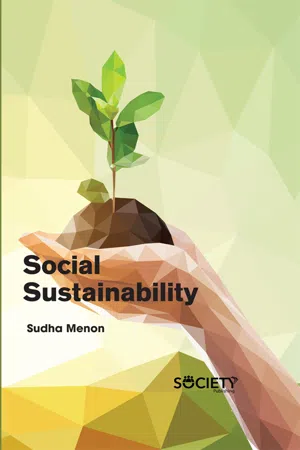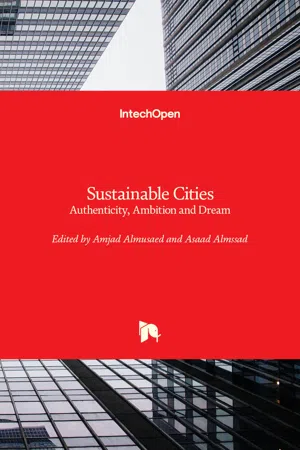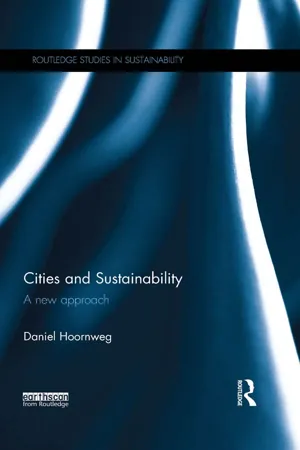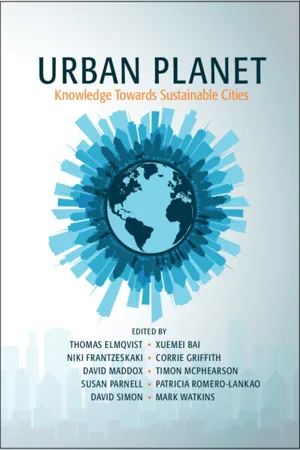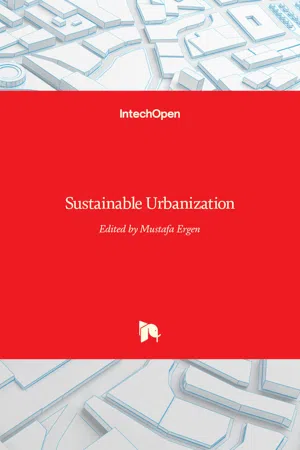Geography
Urban Sustainability
Urban sustainability refers to the ability of a city or urban area to meet the needs of its current population without compromising the ability of future generations to meet their own needs. This involves creating environmentally friendly and efficient infrastructure, promoting social equity, and fostering economic prosperity. It aims to balance economic, social, and environmental factors to ensure the long-term viability of urban areas.
Written by Perlego with AI-assistance
Related key terms
1 of 5
9 Key excerpts on "Urban Sustainability"
- eBook - PDF
- Ronan Paddison(Author)
- 2000(Publication Date)
- SAGE Publications Ltd(Publisher)
All this has far-reaching consequences for urban science and environmental planning. In a condition of relative demographic and economic equilibrium between city and countryside, the destiny of cities depends heavily upon the quality of their own physical lay-out, internal functioning and equilibrium between the built and the natural environment. In a condition of imbalance, on the contrary, their destiny depends upon the develop-ment process that is happening outside them; any policy intervention on urban assets is destined to amplify the perceived disparity in the develop-ment potential between the city and the 136 Handbook of Urban Studies countryside, fostering cumulative immigration processes that annihilate the potential effects of the initial intervention (Lo, 1992). Consequently, in developing countries, policies addressed to the sustainable development of big cities should be complemented in parallel by: • policies focused on a balanced regional devel-opment, and in particular policies for the development of rural areas; • policies focused on the construction of a balanced urban system, based on a creative, country-specific blending of the traditional hierarchical pattern of centres and the modern network pattern of specialized centres (Camagni, 1992; Camagni, 1994). 8.7. Urban Sustainability PRINCIPLES AND POLICY IMPLICATIONS As mentioned above, the strict application of Urban Sustainability requires a focus on the economic, social and environmental aspects of urban life (cf. Newman and Thornley, 1994). This calls usually also for a strict urban energy conservation policy (see Banister, 1996b; Newman and Kenworthy, 1989, 1991). In many cases, targets and critical limits for various aspects (indicators) of Urban Sustainability have to be specified (for example, noise level, CO 2 levels, density, traffic etc.). - eBook - PDF
- Sudha Menon, University of Kerala, India(Authors)
- 2019(Publication Date)
- Society Publishing(Publisher)
Sustainability: A Global Perspective 2 CONTENTS 2.1. Introduction ...................................................................................... 24 2.2. Economic, Social, And Environmental Sustainability In Development Theory And Urban Planning Practice .................... 28 2.3. The Social Discourse And Sustainability ............................................ 29 2.4. Methods For Achieving Sustainable Design ....................................... 33 2.5. Sustainable Development (SD) .......................................................... 39 2.6. Importance Of Sustainable Development (SD) .................................. 44 References ............................................................................................... 49 Social Sustainability 24 Sustainability is the capability of being maintained at a certain level. Sustainable development (SD) is defined as the development that meets the requirements present without compromising with the requirements of future generations. The chapter deals with the notion of sustainability together with SD in which the current approach of modern generation has also been described. Economic, social, and environmental sustainability in urban planning and development theory has been discussed in brief. The relation between social discourse and sustainability, methods for acquiring sustainability such as life cycle design, humane design, etc. have also been explained. Later on, the three key pillars of SD are provided, followed by the significance of SD. 2.1. INTRODUCTION Sustainability can be best defined as the capacity to endure. The word sustainability is derived from the Latin sustinere (tenere, to hold; sus, up). Dictionaries provide more than 10 meanings for sustain, the main ones being to “maintain,” “support,” or endure, that we are discussing about. If we study ecology, Sustainability defines how biological systems remain diverse and productive over time. - eBook - PDF
Sustainable Cities
Authenticity, Ambition and Dream
- Amjad Almusaed, Asaad Almssad, Amjad Almusaed, Asaad Almssad(Authors)
- 2019(Publication Date)
- IntechOpen(Publisher)
That way, high-quality service can be deliv -ered in the most cost-effective way. In a long-term economic focus that embraces social and environmental factors, there are often much more significant gains to be anticipated for the benefit of both business and society in general. In other words, there may be growth and jobs in social and green sustainability as well as an export potential in sustainable urban solutions. 4. Recommendation For a future arrangement of sustainable cities, the new urban agenda, adopted in Quito (Ecuador) on October 17, 2016, complements the 17 sustainable development goals assumed Introductory Chapter: Overview of Sustainable Cities, Theory and Practices http://dx.doi.org/10.5772/intechopen.82632 11 by world leaders at the end of 2015 through Agenda 2030 for Sustainable Development. The Strategic Vision of Sustainable Urbanization, negotiated for more than 3 years and presented at the Conference on Housing and Sustainable Urban Development (Habitat III), provides for a comprehensive approach to urbanization for the next 20 years. Thus, the sustainable urban development agenda proposed by UNDP is focused on concrete actions and sets global stan -dards for sustainable urban development. It also includes a series of recommendations cen -tered on rethinking how people will build, manage and live in cities by 2036 [5]. The economic and environmental footprint of urban centers is very high, despite the fact that they only cover a small part of the globe (0.51% of total land area globally). In terms of percentages, cities accounted for over 80% of world GDP in 2014, producing more than 70% of global greenhouse gas emissions and 80% overall energy consumption. At the same time, experts estimate that in 20–30 years the development of urban centers will be significant, tripling in size and reaching about 1.2 million square kilometers in 2030. - eBook - PDF
Transparent Urban Development
Building Sustainability Amid Speculation in Phoenix
- Benjamin W. Stanley(Author)
- 2017(Publication Date)
- Palgrave Macmillan(Publisher)
When connecting these theoretical ideas to the specifics of place-based sustainable development in the United States—the ultimate goal of this chapter—a number of other perspectives demand attention. Built environment and community activist approaches REGIONAL FRAMEWORKS FOR SUSTAINABLE DEVELOPMENT 22 to sustainable urban development have merged together over the past 25 years to promote a “new localism” (Bruyn 1987; Gunn and Gunn 1991; DeFilippis 1999; Hess 2010), “a viewpoint that asserts the efficacy of localities in promoting sustainability” (Krueger and Gibbs 2007, 3). This emergent focus on municipal-scaled development approaches pairs nicely with geographic theories of bioregional design and knowledge-based socio-economic agglomeration. Together, these strands of thought help inform a novel definition of sustainable urban development based on the notion of transparency in political economic processes. Regional Economic Development A long-standing theoretical tradition has linked the historical formation of dense, diverse cities to the fundamental drivers of industrial growth. Associating urbanization with economic success rests on the aforemen- tioned notion that localized human activity can produce efficiencies of coordination. In an overview of the evolution of urban societies, Leeds (1980) argues that the localization of people and goods leads to a positive feedback loop of needs, service agglomeration, and production—critical ingredients for expanding the division of labor and socio-economic com- plexity. He writes, “in other words, it is easier to get things done and the outcomes are more certain when people are close together, a truth for all human societies” (Leeds 1980, 7). Other authors argue that the urban role in economic growth is even more dynamic because these agglomera- tions provide a perfect foundation for the innovation and cultural devel- opment at the core of novel economic growth (Jacobs 1969; Newman and Jennings 2008; Glaeser 2011). - eBook - PDF
Sustainable Development as a Civilizational Revolution
A Multidisciplinary Approach to the Challenges of the 21st Century
- Artur Pawlowski(Author)
- 2011(Publication Date)
- CRC Press(Publisher)
• Providing cheaper accommodation space. • Protecting children against the hazards typical of cities. • The need for peace and quiet. The listed expectations have their ecological dimension (contact with nature), economic dimension (cheaper accommodation space), and also social dimension (sense of security, escape from the hustle and bustle of city life). Moreover, one can point to the low population density in rural areas. This prompts the development of strong social relations; everybody knows each other, no one is anonymous. Things look different in the case of cities. Here, the population is very dense, and the social relations are not as strong as in the country (related to, for example, the high level of anonymity). Proper, and hence, sustainable, urban environment management is a major challenge in this context. Table 28 presents the classic definitions on this matter. The discussion was expanded within the last few years. Wojciech Peski (1999) perceives such management as an activity directed at securing the effi-cient operation and sustainable development of a historically shaped settlement. This general statement is then fleshed out in more detail by indicating the pri-mary objectives of such development: • To increase the income of both the city and its residents. • To increase employment. • To support actions directed at increasing the level of a city’s economic self-reliance. • To support actions directed at improving the state of the environment (Peski, 1999). These tasks and needs must be realized in such a way as not to impair the future generation’s ability to meet their needs—which is a direct reference to sustainable development. Such an approach expands the discussion by environ-mental and social aspects. The concepts of ‘ecological cities’ also goes in this direction (Bithas & Christofakis, 2006). - Sushila Sinha(Author)
- 2020(Publication Date)
- Society Publishing(Publisher)
Sustainability tends to affect each and every level of organization, be it the local neighborhood be it the entire planet.” Sustainability is achieved when all people on Earth can live well without compromising the quality of life for future generations. --Rolf Jucker, “A Vision for a Sustainable University ” As per the views of John B. Cobb Jr. (in “Sustainability and the Liberal Arts” Conference, 1998), “If the history is considered, then the term ‘sustainable’ arose from those having environmental concerns and most of the literature as well as assess-ment instruments are there which tend to reflect this emphasis. However, it is mainly recognized that without addressing the social justice issues, the sustainability cannot be achieved. Without any social justice, there can be no sustainable communities and institutions. An essential part of true sustainability is the human consideration towards Sustainability is “a process that helps create a vibrant economy and a high quality of life, while respecting the need to sustain natural resources and protect the environment. It expresses the principle that future generations should live in a world that the present generation has enjoyed but not diminished.” --Clough, G. Wayne, Jean-Lou Chameau, and Carol Carmichael. “Sustainability and the University.” The Presidency, winter 2006. Introduction to the Sustainable Development Goals and Objectives 14 the whole community of life. An academic institution which is committed to the sustainability is required to help the students in understanding the roots of injustices of today and furthermore, motivate them to seek justice and humaneness in full integration along with understanding the roots of environmental degradation as well as modeling the sustainable practices environmentally.” According to the statements provided by Alan AtKisson (in “The Compass of Sustainability,” 1998), “Sustainability is considered as an ideal end – state.- eBook - ePub
Cities and Sustainability
A new approach
- Daniel Hoornweg(Author)
- 2016(Publication Date)
- Routledge(Publisher)
3 The urbanscape Why cities are at the core of sustainabilityMuch on sustainable development is written from the perspective of countries, or from one of the multitude of people to have attended some related UN conference. Cities as the single largest drivers of the world’s economy, and the single largest generators of pollution and waste, are relatively quiet in the sustainable development debate. This is mostly by design, as cities usually defer to national (or state/provincial) representatives. Local imperatives are often difficult to contextualize in global conversations.Corporations and countries are usually the main agencies to advocate for and measure sustainability. In the case of planetary boundaries, a global metric is used. Corporations usually pursue sustainable development objectives within the context of market-share protection and enhancement. And as future companies are not able to lobby and promote their perspective, existing corporations implicitly encourage the status quo and sustained profitability. Countries advocating for sustainable development must do so within the constraints of possible regional tensions at home, protection of territorial integrity, and geopolitical considerations. Cities, on the other hand, are increasingly measuring sustainability through service provision standards and local quality of life (well-being).Measuring sustainability
Countries are transient, cities less so. Heads of state spend considerable efforts safeguarding country borders and powers, mayors less so. For example, two-thirds of today’s 195 member countries did not exist in 1945, when the UN was established. Every one of the 120 ‘Future Five’ cities was a large urban conurbation in 1945, most having had continuous human habitation at their location for more than 200 years. The political borders of cities may be as fluid as national borders; however, sustained residency in key urban areas is common for most cities. - eBook - PDF
Urban Planet
Knowledge towards Sustainable Cities
- Thomas Elmqvist, Xuemei Bai, Niki Frantzeskaki, Corrie Griffith, David Maddox, Timon McPhearson, Susan Parnell, Patricia Romero-Lankao, David Simon, Mark Watkins(Authors)
- 2018(Publication Date)
- Cambridge University Press(Publisher)
Sánchez-Rodríguez, R. (2008). Urban Sustainability and Global Environmental Change: Reflections for an Urban Agenda in G. Martine, G. McGranahan, M. Montgomery and R. Fernández- Castilla (Eds.), The New Global Frontier Urbanization, Poverty and Environment in the 21st Century. London and Sterling, VA: Earthscan, pp. 149–164. Sánchez-Rodríguez, R., Seto, K. C., Simon, D., Solecki, W. D., Kraas, F., and Laumann, G. (2005). Science Plan Urbanization and Global Environmental Change Project (IHDP Report No. 15). Bonn: International Human Dimensions Programme on Global Environmental Change. Satterthwaite, D. (1993). The Impact on Health of Urban Environments. Environment and Urbanization, 5 (2): 87–111. Satterthwaite, D. (1997). Sustainable Cities or Cities That Contribute to Sustainable Development? Urban Studies 34 (10): 1667–1691. Seto, K.C., Solecki, W.D., and Griffith, C.A. (eds.) (2016). The Routledge Handbook of Urbanization and Global Environmental Change. London and New York: Routledge. Seto K.C., S. Dhakal, A. Bigio, H. Blanco, G.C. Delgado, D. Dewar, et al. (2014). Human Settlements, Infrastructure and Spatial Planning in Edenhofer, O., R. Pichs-Madruga, Y. Sokona, E. Farahani, S. Kadner, K. Seyboth, et al. (eds.) Climate Change 2014: Mitigation of Climate Change. Contribution of Working Group III to the Fifth Assessment Report of the Intergovernmental Panel on Climate Change. Cambridge: Cambridge University Press. Seto, K.C., Reenberg, A., Boone, C.G, Fragkias, M., Haase, D., Langanke, T., et al. (2012). Urban Land Teleconnections and Sustainability. Proceedings of the National Academy of Sciences, 109(20): 7687–7692. Simon, D. (1989). Sustainable Development: Theoretical Construct or Attainable Goal? Environmental Conservation 16(1): 41–48. Simon, D. (2003). Dilemmas of Development and the Environment in a Globalising World: Theory, Policy and Praxis, Progress in Development Studies 3(1): 5–41. - eBook - PDF
- Mustafa Ergen(Author)
- 2016(Publication Date)
- IntechOpen(Publisher)
Nevertheless, several international research groups have ascertained the © 2016 The Author(s). Licensee InTech. This chapter is distributed under the terms of the Creative Commons Attribution License (http://creativecommons.org/licenses/by/3.0), which permits unrestricted use, distribution, and reproduction in any medium, provided the original work is properly cited. influence of the urban form on local microclimate. 1 In fact, the way in which buildings are arranged on a site heavily affects their owners’ energy performances and environmental behaviours. The growing awareness of these issues is gradually attracting the attention of both international organizations and international researchers towards the urban dimension (urban block or district), thus broadening the field of architectural interventions. In this light, urban design, which lies in‐between urban planning and architectural design, has become the appropriate tool through which to operate in achieving sustainability's goals. This recommen‐ dation, however, is not novel. In 1976, the European Commission suggested it during the first United Nations Conference on Human Settlements, ‘Habitat’ (Vancouver), in which the ‘design of human settlement’ was recognized as a strategic matter in contrasting the «social, economi‐ cal, ecological and environmental deterioration» of urban areas [1]. Nevertheless, the latest ‘sustainable urban design’ seems to increase its own complexity due to the involvement of different interrelated disciplines, such as fluid dynamics, climatology, technical physics and computer engineering. This interdisciplinary perspective demands updates to the design process in order to incorporate external contributions while maintaining architecture at the heart of the process. In particular, both environmental data and analyses need to be reintegrated into the urban project from the design's initial phases.
Index pages curate the most relevant extracts from our library of academic textbooks. They’ve been created using an in-house natural language model (NLM), each adding context and meaning to key research topics.

